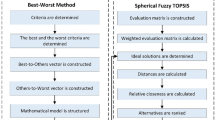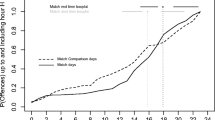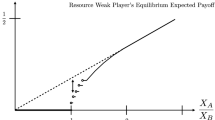Abstract
The success of military operations depends on soldiers’ execution of the operation as well as resources used for the operation. However, this does not mean that more men and firepower will ensure victory. Military units, just like any other organization, are collections of distributed elements, and improving the organization or command and control (C2) structure of such elements will ultimately show the true power of more men and resources. This paper presents a case study comparing two C2 structures in a counterfire operation, which is a very realistic scenario in some parts of the world. We modeled each structure with meta-networks and agent-based simulations, and then determined why one structure has a better outcome in the simulation. In particular, we jointly analyze the virtual experiment and network metrics, i.e., centralities, to identify the important resources and human factors. This research provides critical insight and suggestions to reform the C2 structure based on quantitative findings. In terms of the C2 structure, assigning detection units to the decentralized echelon brings about the reduction of the time for the targeting process, while the strengthened gun power for multiple targets is proved to have strong influence from the operational perspective.















Similar content being viewed by others
Notes
TPQ means Transportable Multipurpose Radar, and TGT is an abbreviation of target.
References
Air force U (2009) Air force test and evaluation presentation. US Airforce T/E days (2009)
Alberts DS, Hayes RE (2003) Power to the edge: command... control... in the information age. Tech. rep., DTIC Document
Arbib MA (1972) Theories of abstract automata
Army U (1976) Fm 6-40/mcwp 3-16.4 tactics, techniques, and procedures for field artillery manual cannon gunnery (field manual). US Army, Jan 9
Army U (2001) Fm 3-09.21 ttp for the field artillery battalion. US Army
Army U (2004) Fm 3-09.50 ttp for the field artillery howitzer battery. US Army
Army R (2006a) Fm 3-20 ttp for the field artillery battalion. ROK Army
Army R (2006b) The guidance for fire operation analysis model. ROK Army
Army R (2008) Fm 32-1 field artillery operations. ROK Army
Army U (2012) Atp 3-09.24 techniques for the fires brigade. US Army
Baber C, Harris D, Stanton NA (2012) Modelling command and control: event analysis of systemic teamwork. Ashgate Publishing Ltd, Farnham
Bae JW, Lee G, Moon IC (2012) Formal specification supporting incremental and flexible agent-based modeling. In: Simulation Conference (WSC), Proceedings of the 2012 Winter, pp 1–12. IEEE
Bailey JB (2003) Field artillery and fire power. Routledge, London
Borshchev A, Filippov A (2004) Anylogic-multi-paradigm simulation for business, engineering and research. In: The 6th IIE annual simulation solutions conference, vol. 150, p 45
Brehmer B (2005) The dynamic ooda loop: Amalgamating boyds ooda loop and the cybernetic approach to command and control. In: Proceedings of the 10th international command and control research technology symposium
Brown RH (1978) Bureaucracy as praxis: toward a political phenomenology of formal organizations. Administrative Science Quarterly, pp 365–382
Carley KM, Lin Z (1995) Organizational designs suited to high performance under stress. IEEE Trans Syst Man Cybern 25(2):221–230
Carley KM, Lin Z (1997) A theoretical study of organizational performance under information distortion. Manag Sci 43(7):976–997
Carley KM, Lee JS, Krackhardt D (2001) Destabilizing networks. Connections 24(3):31–34
Carley KM, Lee JS, Krackhardt D (2002) Destabilizing networks1. Connections 24(3):79–92
Carley KM, Pfeffer J, Reminga J, Storrick J, Columbus D (2013) Ora user’s guide 2013. Tech. rep, DTIC Document
Chung Y, Shin K, Park J (2008) A study on mine artillery hit using devs. Korea Simul Conf 17(3):45–51
Costa A, McShane MK, Pinto CA (2015) Investigating interbank contagion with agent-based modeling and functional dependency network analysis (fdna)
Cramer M (2008) Understanding information uncertainty within the context of a net-centric data model: a mine warfare example. Tech. rep, DTIC Document
Friedkin NE (1991) Theoretical foundations for centrality measures. Am J Sociol 96(6):1478–1504
Garvey PR, Pinto CA (2009) Introduction to functional dependency network analysis. In: the MITRE corporation and Old Dominion, Second International Symposium on Engineering Systems, MIT, Cambridge, Massachusetts, vol 5
Grant T, Kooter B (2005) Comparing ooda & other models as operational view c2 architecture topic: C4isr/c2 architecture. ICCRTS2005, Jun
Guetzkow H, Simon HA (1955) The impact of certain communication nets upon organization and performance in task-oriented groups. Manag Sci 1(3–4):233–250
Gutiérrez TN, Ciarletta L, Chevrier V (2014) A control architecture of complex systems based on multi-agent models. In: international conference on practical applications of agents and multi-agent systems, pp 207–218. Springer, New York
Kim SY, Lee JY (2008) An improvement of hit-probability and an efficient counter-fire execution. Korea simulation conference, pp 143–152
Kim TG, Moon IC (2012) Combat modeling using the devs formalism. Eng Princ Combat Model Distrib Simul 479–510
Kim TG, Zeigler BP (1987) The devs formalism: hierarchical, modular systems specification in an object oriented framework. In: proceedings of the 19th conference on Winter simulation, pp 559–566. ACM
Kim J, Choi C, Moon IC, Kim T (2010) Devs-based doctrine validation of fleet anti-air defense. In: proceedings of the 2010 Spring simulation multiconference. Society for Computer Simulation International, p 28
Lanham MJ, Morgan GP, Carley KM (2014) Social network modeling and agent-based simulation in support of crisis de-escalation. IEEE Trans Syst Man Cybern 44(1):103–110
Lauren M, Stephen R (2002) Map-aware non-uniform automata (mana)-a new zealand approach to scenario modelling. J Battlef Technol 5:27–31
Lee ST (2011) A study on the method of attacking mine artillery using target acquisition radar. Korea advanced institute of science and technology, pp 1–55
Lee D, Choi BK, Kong J (2010) Timer embedded finite state machine modeling and its application. In: ECMS, pp 153–159
Li B, Sun D, Zhu R, Li Z (2015) Agent based modeling on organizational dynamics of terrorist network. Discrete Dyn Nat Soc
Lim JW (2012) Study on modelling and analysis of counterfire warfare for tactical operations and acquisition. Korea advanced institute of science and technology, pp 1–82
McDonald M (2010) Crisis status in south korea after north shells island. http://www.nytimes.com/2010/11/24/world/asia/24korea.html?src=mv
Melo MT, Nickel S, Saldanha-Da-Gama F (2009) Facility location and supply chain management-a review. Eur J Oper Res 196(2):401–412
Mizgier KJ, Wagner SM, Holyst JA (2012) Modeling defaults of companies in multi-stage supply chain networks. Int J Prod Econ 135(1):14–23
Newman ME (2001) Clustering and preferential attachment in growing networks. Phys Rev E 64(2):025102
Roza ZC (2005) Simulation fidelity theory and practice. Delft University of Technology, Delft
Sung CH, Moon IC, Kim TG (2010) Collaborative work in domain-specific discrete event simulation software development: Fleet anti-air defense simulation software. In: 2010 19th IEEE international workshop on enabling technologies: infrastructures for collaborative enterprises (WETICE), pp 160–165. IEEE
Wasserman S (1994) Social network analysis: methods and applications, vol 8. Cambridge University Press, Cambridge
Zavarelli J, DeChiaro SA, Fournier J, Schweickert DA, Zislin A(2006) Live virtual constructive experiments for c2 evaluation. In: 11th ICCRTS, p 90
Zeigler BP, Praehofer H, Kim TG (2000) Theory of modeling and simulation: integrating discrete event and continuous complex dynamic systems. Academic Press, Cambridge
Acknowledgements
This work was conducted at High-Speed Vehicle Research Center of KAIST with the support of Defense Acquisition Program Administration (DAPA) and Agency for Defense Development (ADD).
Author information
Authors and Affiliations
Corresponding author
Rights and permissions
About this article
Cite this article
Shin, SJ., Kang, A., Kim, D. et al. Improving counterfire operations with enhanced command and control structure. Comput Math Organ Theory 25, 464–498 (2019). https://doi.org/10.1007/s10588-018-9278-4
Published:
Issue Date:
DOI: https://doi.org/10.1007/s10588-018-9278-4




